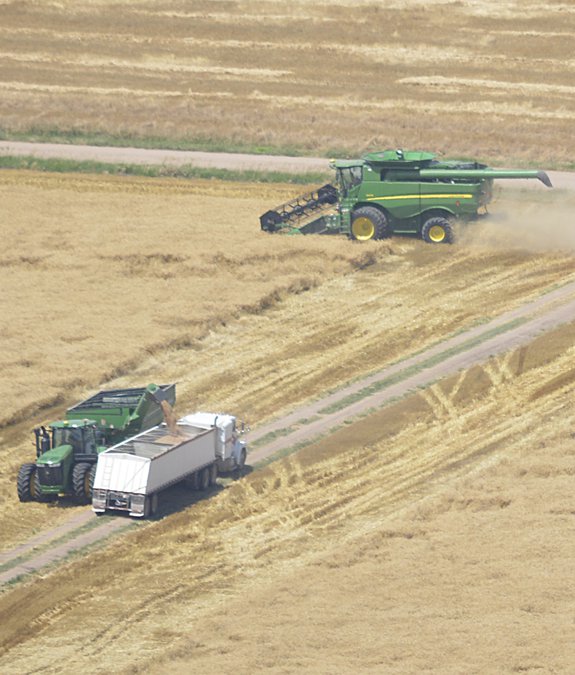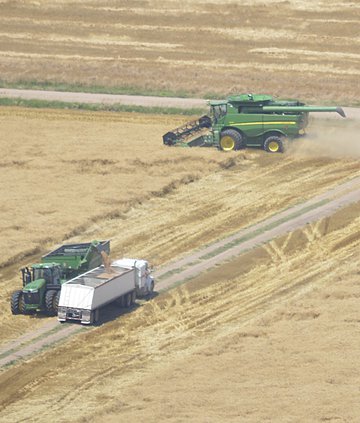Among Kansas landowners, it’s a seller’s market — for those desiring to sell.
After a fall-off through 2020, reports of farmland prices, which includes building values, have increased about 11% over the past year to around $2,100 per acre. Cropland is up almost 14%.
In the Great Plains, Kansas trails only Nebraska in both categories. Nationally, the average farmland acre sells for $3,400, while cropland is going for $4,400.
The trend means that farmers looking to relocate and non-farm investors looking for a place to grow are turning toward the Sunflower state.
The flip side, however, means that it’s harder to expand or start a Kansas farm.
“It’s made it more difficult not only for farmers looking to expand, but also for those new farmers to get in,” noted Mark Nelson, Kansas Farm Bureau Director of Commodities.
Dean Klauer, director of Stockgrowers in Kansas, said the rise is due to several factors. “There are several reasons for the current increase in farm real estate and crop land values,” he said. Historically low interest rates, a better agricultural economy, increased demand for urban use and other outside investments are combining to push prices up.
An increase in land price toward an overall increase in valuation is an important metric for farmers looking for bank loans. Increasing net worth can improve the financial condition of the farm for the next generation, if the farm is carried forward.
But high start-up costs may deter early growers, who are turning to lease rather than purchase.
Higher rental rates also reduce margins and make it more difficult to buy, Klauer said.
Meanwhile, farmers are finding it difficult to get needed everyday supplies, due to COVID supply-change issues. Increased prices in such products as natural gas, used in the making of fertilizer, tend to nullify any gains made from increased crop sales.
This year’s activity can be viewed as a market turnaround. “Right now, the prices are moving back to where they were in about 2013-15,” notes Kevin Keller, of Keller Real Estate in Great Bend. Back then, commodities and industry prices were contributing to that price increase, he said. “People were taking cash from instruments with a low rate of return and putting it into other investments. I would look at that as some of the drivers. In this realm, right now, I would say it is stable, and is going to appreciate.”
Besides drawing “absentee landlords,” the uptick is also drawing non-farm investors from out-of-state, which may drive prices even higher.
“Investors are looking for an outlet for what you could call ‘COVID money.’ There is more money out there for people to reinvest,” Keller said.
Tyson Steffen, owner of Clock Realty and Insurance in Larned, said he believe reports of the price trend are accurate for the central part of the state.
“I would say, yes, 11% is relevant to our area, and I would say that it would be a conservative number,” he said.
“There is just not a lot of ground for sale and there are a lot of buyers in the market. Investor buyers are looking at the Pawnee County area; they know what the ground is worth and they are willing to pay good money for good ground.”
Steffen said the county has been insulated somewhat from the national trend, which has seen record prices and sales over the past eight months.
“You will see farmers retiring,” he said. “There are a lot of guys wanting to retire and there is not enough new guys coming in. There are younger farmers out there, but it is the investor buyer who is driving the market right now.”
Political climate, the general economy and gains in other sectors influence the investor buyers, Steffen noted. “It’s not just the price of agricultural land. We do see some that are looking to relocate their farming operation. It has been the trend to move away from this area, but it is turning around.
“It’s an interesting market,” Steffen said.
The overall real estate market has seemed to stabilize heading into the next year, notes Rita Kurtz, of Carr Auction and Real Estate.
“The housing market was way up for a while. We had a very hot market, but it is starting to cool down,” she said. “The agricultural market has been up for about eight months out of the year. We do have a lot of out-of-area calls looking to move back to this part of the country. It could be political reasons (such as government mandates).
“Even though it has cooled down, I’m still getting calls from out-of-state,” Kurtz said.
“Our community isn’t much different than say, Great Bend or Pratt,” she added. “We have the same basic issues such as inventory, sales upticks, investor buying – I think that’s pretty much the same across the board.”
There are also the regional movers, who are looking to make a climate or geographic change, Kurtz said.
“I had a lady call the other day from California, and she said she was just getting tired of all the fires and she wanted to move out of that area,” Kurtz said.
“Around here, we would like to see the population go up, the school enrollment go up; they have been in a steady decline,” she said. “But these things run in cycles and we’re used to seeing them go up and down.”





